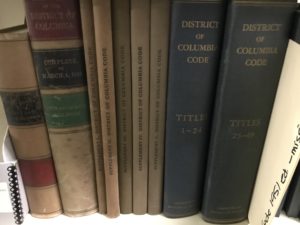This post is a bit of a “what would YOU do?” request for input. Let me begin with the background:
I am, on behalf of my office, working on a project to digitize (*cough*scan*cough*) all of the D.C. Laws from Council periods 1 through 7. These are unofficial copies, and are online in concert with the unofficial D.C. Code that while unofficial is the easiest to use in most circumstances. The scanning has been done by two interns placed with my office through Urban Alliance (I wrote about Urban Alliance before), the first who did a huge amount of work and the second who is going through and picking up where things were missed or scanned from poor copies.
And thus we have the phenomenon that leads me to my question. I now have in some cases two scanned versions of a law, each with its own problem. You know how you can have two of (a) good, (b) fast, and (c) cheap, but not all three? Well, in some cases I can have two of (a) legible margins (that is, from a flat original), (b) bottom lines of text not cut off, or (c) consistent appearance (that is, all of the pages from the same “original” and not combined from two separate scans).
In an ideal world, we would go and search out the original and scan from there. But that’s not happening here. It isn’t an ideal world, we don’t have perfect resources, and these aren’t intended to be archival quality. (There IS a risk that they could be used as “oh, someone’s already scanned these, yay we don’t have to.”)
Here is an example of this situation. What would you do? 1. Use the scan with poor margins. (law 5-129) 2. Use the scan with the bottom of the first page cut off. (L5-129) 3. Use page 1 of the scan with poor margins and the rest of the pages from the other scan. 4. Throw it all together in a single PDF because the scan with the problem on the first page also doesn’t have page numbers.
L5-129 law 5-129

